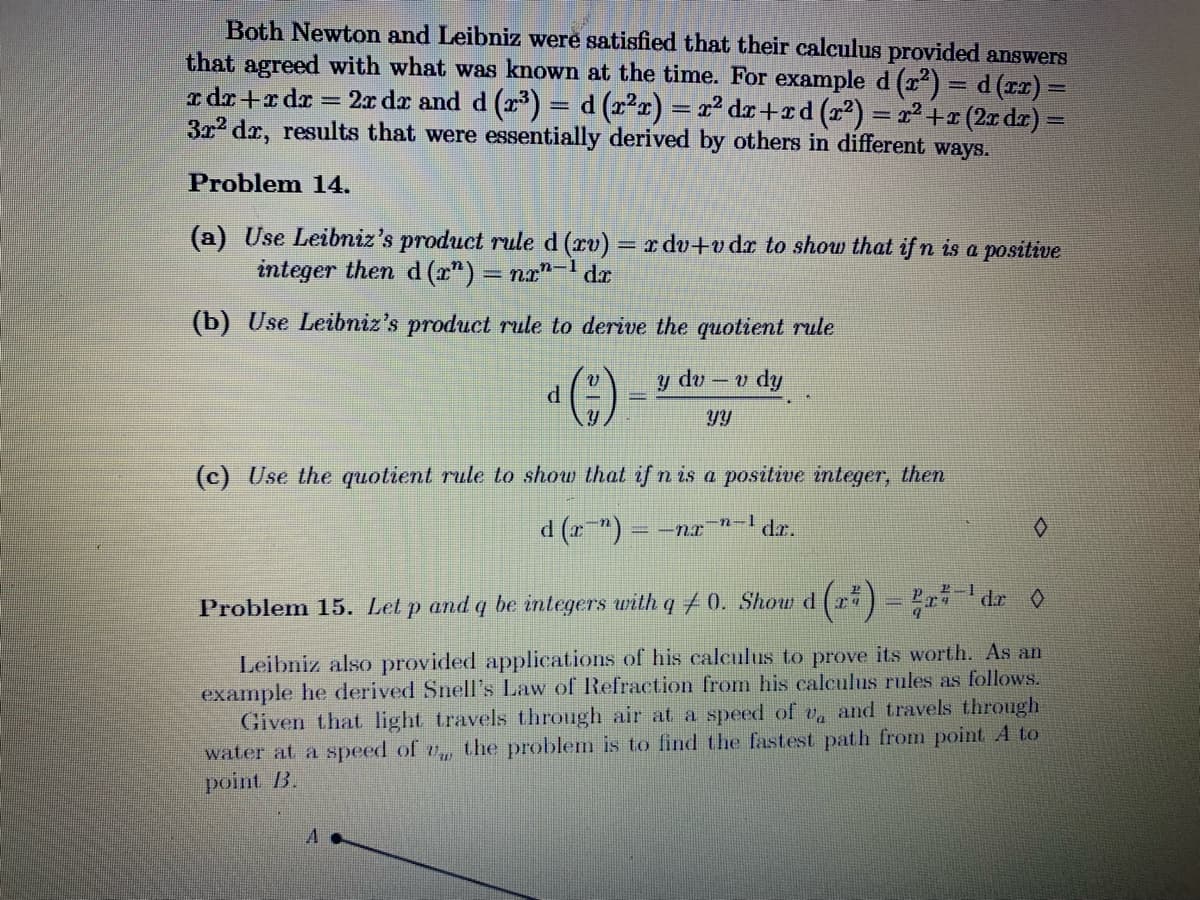Both Newton and Leibniz were satisfied that their calculus provided answers that agreed with what was known at the time. For exampled (r) = d (rr) = a dr+r dr = 2x dr and d (r) = d (r²r) = x² dI+rd (r²) = x² +I (2x dr) = 32 dr, results that were essentially derived by others in different ways. Problem 14. (a) Use Leibniz's product rule d (ru) = rdv+v dr to show that if n is a positive integer then d (r") = nr"-' dr n-1 (b) Use Leibniz's product rule to derive the quotient rule y du- v – v dy YY (c) Use the quotient rule to show that if n is a positive integer, then d (r ") - -nx n-1 dr. Problem 15. Let p and q be integers with q + 0. Show d (r) = P dr 0 Leibniz also provided applications of his calculus to prove its worth. As an example he derived Snell's Law of Refraction from his calculus rules as follows. Given that light travels through air at a speed of v, and travels through water at a speed of u, the problem is to find the fastest path from point A to point B.
Both Newton and Leibniz were satisfied that their calculus provided answers that agreed with what was known at the time. For exampled (r) = d (rr) = a dr+r dr = 2x dr and d (r) = d (r²r) = x² dI+rd (r²) = x² +I (2x dr) = 32 dr, results that were essentially derived by others in different ways. Problem 14. (a) Use Leibniz's product rule d (ru) = rdv+v dr to show that if n is a positive integer then d (r") = nr"-' dr n-1 (b) Use Leibniz's product rule to derive the quotient rule y du- v – v dy YY (c) Use the quotient rule to show that if n is a positive integer, then d (r ") - -nx n-1 dr. Problem 15. Let p and q be integers with q + 0. Show d (r) = P dr 0 Leibniz also provided applications of his calculus to prove its worth. As an example he derived Snell's Law of Refraction from his calculus rules as follows. Given that light travels through air at a speed of v, and travels through water at a speed of u, the problem is to find the fastest path from point A to point B.
Mathematics For Machine Technology
8th Edition
ISBN:9781337798310
Author:Peterson, John.
Publisher:Peterson, John.
Chapter47: Applications Of Formulas To Cutting Speed, Revolutions Per Minute, And Cutting Time
Section: Chapter Questions
Problem 47A
Related questions
Question
100%
#14 part c please

Transcribed Image Text:Both Newton and Leibniz were satisfied that their calculus provided answers
that agreed with what was known at the time. For exampled (r) = d (rr) =
I dr+rdx
3a2 dr, results that were essentially derived by others in different ways.
= 2x dæ and d () = d (x²x) = r² dr+xd (r²) = 2² +x (2x dr) =
%3D
Problem 14.
(a) Use Leibniz's product rule d (ru) = rdv+v dr to show that if n is a positive
integer then d (r") = nx"-1
de
(b) Use Leibniz's product rule to derive the quotient rule
y dv- v
– v dy
YY
(c) Use the quotient rule to show that if n is a positive integer, then
- (u-x) p
Problem 15. Let p and q be integers with q 4 0. Show d (r) = r dr 0
= -nr
n-1
dz.
Leibniz also provided applications of his calculus to prove its worth. As an
example he derived Snell's Law of Refraction from his calculus rules as follows.
Given that light travels through air at a speed of v, and travels through
water at a speed of v, the problem is to find the fastest path from point A to
point B.
Expert Solution
This question has been solved!
Explore an expertly crafted, step-by-step solution for a thorough understanding of key concepts.
This is a popular solution!
Trending now
This is a popular solution!
Step by step
Solved in 2 steps with 2 images

Recommended textbooks for you

Mathematics For Machine Technology
Advanced Math
ISBN:
9781337798310
Author:
Peterson, John.
Publisher:
Cengage Learning,

Mathematics For Machine Technology
Advanced Math
ISBN:
9781337798310
Author:
Peterson, John.
Publisher:
Cengage Learning,